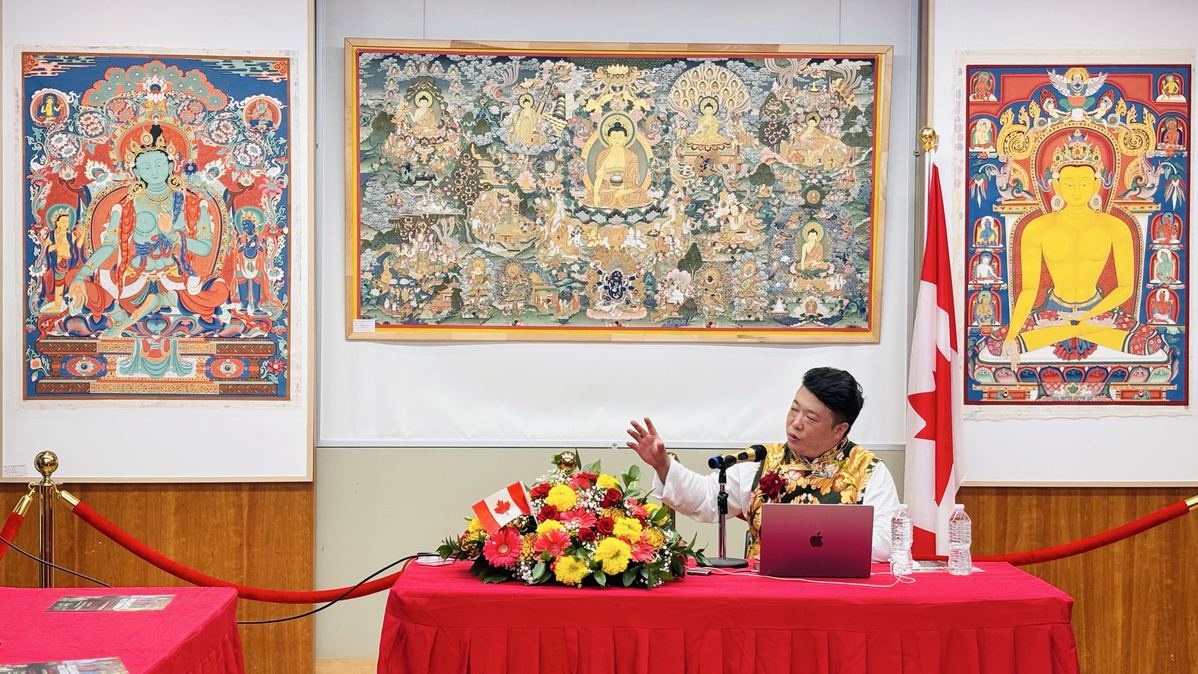Thangka artist's work imbued with tradition


A master of the art of thangka says it is "not only the heritage of China, but also that of the world".
Sangye Tsering recently concluded a thangka art exhibition in Toronto on Oct 6. The show, his first in Canada, featured more than 50 thangka paintings.
Sangye Tsering, 36, is from the Regong region of Northwest China's Qinghai province and is one of the youngest inheritors of thangka art in China.
At the exhibition, he was awarded Cultural Ambassador of Chinese Culture by the National Artists Association of Canada for his contribution to sharing and passing on Chinese culture on the international stage.
Thangka is a unique form of painting in Tibetan culture. The pigments used are precious minerals and plants such as saffron, which are not only colorful but can be maintained for hundreds of years.
"This is my life's work, my mission," Sangye Tsering told China Daily. "Thangka is not just about technique; its spirit has long been integrated into my life."
At the age of 8, Sangye Tsering became a disciple of Master Xiawu Cairang, a respected thangka artist and disciple of the famous Chinese painter Zhang Daqian. From his mentor, Sangye Tsering learned the importance of mastering technique and spiritual depth.
"My teacher always said that if you want to create great art, you must master the traditions and classics first," said Sangye Tsering. "He told me that innovation can only come from a solid foundation of tradition. Unless you first understand and respect the tradition, you cannot innovate."
In thangka art, the line is at the core of expression, and solid line skills are the foundation for excellence. His teacher told him that "a single line is worth a horse", which had a profound influence on him. He said that thangka also requires skill in mixing colors.
Sangye Tsering said that studying different artistic styles and cultures, such as ancient Egypt, Greek and Roman painting, has enriched his artistry.
By comparing the techniques and concepts of different genres, he said he has been able to better understand the uniqueness of thangka art and build upon it.
"For example, the early introduction of Buddhism into Tibet was not only a spread of religion, but also an exchange and fusion of different cultures," he said. Such exchanges enabled thangka art to absorb and integrate various cultural elements and form a unique artistic style.
The experience of living in Fujian, especially learning about Mazu culture, also had a significant impact on Sangye Tsering's art.
Mazu is a revered goddess of the sea who is worshipped on both sides of the Taiwan Strait.
He said that a trip to a Mazu temple inspired him. The artist originally planned to paint a portrait of Mazu, but the visit to the temple motivated him to produce a larger-scale work.
He created a work called Shen Zhao Hai Biao that had more than 500 figures. The title means "the divine apparition over the ocean".
"When creating works related to Mazu, it's very important to value the inheritance of traditional culture while also emphasizing innovation," he said.
Sangye Tsering is also committed to the training of the next generation of thangka artists, as he said it's getting more difficult to find young people who want to embrace the challenging art.
"Thangka is not just an art form, it's a way of life," he said. "Through it, we can bring truth, goodness and beauty, which is the essence of what I wish to share with the world."
Sangye Tsering is looking to build a bridge between tradition and innovation.
"My art is about finding that balance," he said. "I believe that when people see the beauty in a thangka, they see something deeper than just a painting."

































